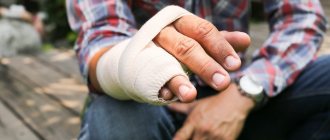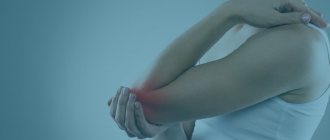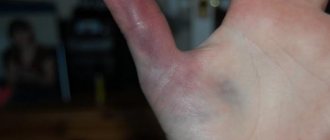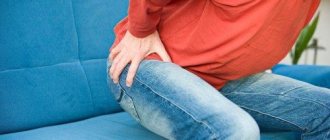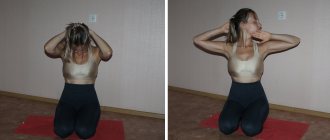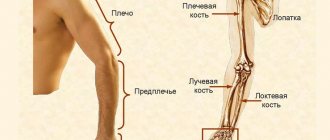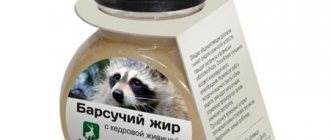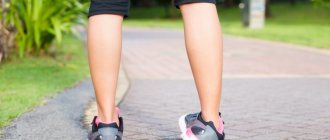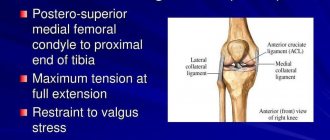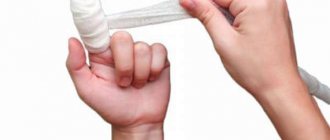A finger sprain is a common injury characterized by damage or tearing of the connective tissue (ligaments, cartilage, and joint capsule) of one or more finger joints.
Each of the 4 fingers - with the exception of the thumb - is made up of 3 small bones known as phalanges. These small bones are connected to each other by the interphalangeal joints and the bones of the palm (metacarpals) at the metacarpal joints, which form 3 joints for each finger. Each of these joints is made up of strong connective tissue wrapped around the bony ends and cartilage that lies between the articular surfaces. Cartilage softens the impact of one bone on another during work, bending the fingers.
During certain movements, tensile or compressive forces are applied to the finger joints. If these forces are excessive due to too many repetitions or too much force, joint injuries occur. These include damage to the cartilage or tearing of the connective tissue surrounding the joint. This condition is known as a finger sprain, which affects one or more finger joints.
Signs and symptoms of a finger sprain
Pain is felt immediately upon injury. However, pain and stiffness also comes after the activity that provokes them, in particular, the next morning. Symptoms are felt on the front and back of the affected finger joint. During the injury, a crunching sound is heard. Swelling and bruising often develop around the affected joint. Symptoms worsen with activities involving the use of the hand and fingers: catching a ball, opening a jar or door, writing, typing on a keyboard, lifting heavy objects, cooking. The finger hurts a lot when you press on the affected area, and there is a feeling of weakness in the hand. In severe cases, the finger may be completely dislocated. All dislocations must be treated by a medical professional. X-rays must be taken before and after the joint is returned to its place. This confirms movement and excludes fracture.
Finger pain (Treatment and prevention of finger injuries.)
Climbing coach Robin O'Leary has teamed up with physiotherapist Nina Lionfellner to help climbers realize their potential and prevent or treat the most common injuries. In this article we will look at the most common problem - finger injuries.
A click is usually the first sign that you'll need to take a break from climbing.
An MRI image showing the gap between the bone and the ligament, i.e.
there is a complete break UKC Articles, 08 Mar 2014 © Robin O'Leary
In 2012, I myself heard such a click - it was a complete rupture of the A2 ligament in the left index finger. And I asked myself:
Why did it happen so?
How long will it take to cure?
What do I need to do right now and what later to recover better?
Maybe there is a wonderful exercise or procedure that will allow me to quickly get back to the rocks?..
If you have ever had ligament injuries, or are now the proud owner of them, then this article is for you. This article will also be useful for those who have not yet experienced such injuries and want to avoid them in the future. Nina has extensive experience working with such injuries, because most climbers encounter them one way or another, and is ready to answer all our questions.
— Nina, first of all, please tell us about the digital (ring) ligaments. What are they doing?
The finger ligaments hold the flexor tendons of the fingers against the bones, much like the rings hold the line on a fishing rod. Ligaments help transmit muscle force and also help our two flexor muscles glide. In each finger we have five such ligaments, A1-5.
The finger flexor tendons and ligaments experience enormous stress in climbing, especially when using a closed active grip.
finger injury
Finger structure UKC Articles, 08 Mar 2014 © Lippincott, Williams & Wilkins
- So, how do finger ligament injuries occur?
- If you often use a closed active grip with a heavy load.
- If you often use one or two finger pockets with heavy loads.
- If you often use lifts on overhangs with a heavy load.
- If you have weak or tired middle, ring and little fingers (the last three).
- With large body weight.
- Poor core muscle control when climbing.
- When there is sudden stress on the toes due to a slipped foot.
Usually several factors lead to tissue damage. If a single movement requires such effort that it exceeds the threshold of the ligament’s strength, then it becomes stretched or ruptured.
Overuse of a closed active grip weakens the ligaments ,
making them more susceptible to injury .
The A2 and A4 ligaments are positioned in such a way and are subject to the force of both finger flexor tendons that an active grip creates a very strong avulsion load on them. At some point, these forces exceed the strength threshold of the ligament, and it becomes torn, stretched, or ruptured.
Closed active grip on campus board
UKC Articles, 11 Mar 2014 © Steve Gorton
— Nina, I’m sure we have many readers who don’t understand what happened to them—a ligament rupture or something else. How to determine this?
When a tear occurs, you usually hear or feel a clicking sound and there is a painful sensation of tearing. Sometimes, if the ligament has been weakened and overstretched by repeated too much stress, you may feel almost nothing at all.
The pain should be near the joints on the side of the palm where the ligament is located. You may feel a crunching sensation in the ligament area, this is scar tissue. The inflammation depends on how bad your tear is, i.e. on the degree of injury. It can be painful at rest, but more often the pain occurs when trying to bend a finger or when touching it.
“When I tore my finger, I was in shock. I had healthy and strong fingers (as it seemed to me), I trained calmly and nothing bothered me. The clicking sound was very loud. There was bouldering with a two-finger pocket pull on the last hold. My foot didn’t slip, I felt confident, and suddenly this sound. It was a strange sensation, there was no pain, just the whole hand suddenly went numb. I could move my hand, but when I tried to forcefully squeeze my other hand with it, nothing happened. There was no inflammation or bruising as such, but there was pain and that feeling of crepitus that Nina spoke about. Of course, everyone is different, and the most important thing to do is to go to the doctor as soon as possible and check what's wrong. I went straight to the emergency room and had an MRI within a week. With a complete break, I had to stop climbing for several months. Is it necessary to take a break for an ordinary tear?
The A2 and A4 ligaments are critical to holding the tendons to the bones and maximizing leverage. They are like a continuation of the bone, while the A1,3,5 ligaments are a continuation of the flexor cartilaginous plates. The A2 and A4 ligaments influence the transmission of force during finger flexion, so their loss will lead to long-term and significant loss of strength.
To put it bluntly, you will need to take a break. Rest is key, but the amount of rest will depend entirely on the extent of your injury and can range from a few weeks to six months or more.
- Yes, it took me seven months to at least to some extent regain my normal ability to move. Those who had partial tears said six weeks, but a complete tear is a completely different matter.
A tear to the A2 and A4 ligaments in adolescents and young adults who have not fully grown can result in an avulsion fracture, or growth plate fracture, due to the close proximity of these ligaments to bones and joints. In young people, bones are a more fragile structure than ligaments, so pain in the fingers that lasts more than a week is a serious reason to go to the doctor. And any pain in their fingers means they need to take a break from climbing and most likely do rehabilitation exercises.
— Nina, it is clear that many climbers suffer from ligament injuries, but more and more often I see people with inflamed or painful finger joints. What is it and what does it mean for a climber?
Sore finger joints
UKC Articles, 08 Mar 2014 © Waltereo
Knuckle injuries in climbers are also very common, simply due to the very nature of the sport. Small knuckles experience a wide range of stress when climbing. They are compressed, twisted, shifted, pulled, especially when climbing cracks. Our sport is developing, and we accept such extreme positions that in ordinary life do not occur at all and are not familiar to the average person. Movements on the shoulder, throwbacks, grabs, and all this on minuscules or pinches, high above the head or vice versa below. All of these movements create enormous forces that act on very small structures in our body. The finger joints are held in place by ligaments that run along the finger, as well as by the joint capsule. This capsule is also ligamentous, and on the inside it is lined with a membrane that secretes synovial fluid - a lubricant that allows movement in the joint. The ligamentous tissue is subjected to great stress and stretching during climbing, and gradually the joints adapt: scar and bone tissue forms inside the ligaments and articular surfaces, and the bones themselves thicken. This makes the joint stiffer, which is generally good as long as it is not taken to extremes. Over time, this also makes the joint less mobile, and an older climber, if he has not taken care of his fingers, does not stretch them, warm them and massage them, risks limiting the range of movement, which in turn can lead to osteoarthritis. If the joints cannot move in full amplitude, then the synovial fluid is not released in full, the joint does not receive enough nutrients, and this is a movement towards unhealthy joints.
Although movement is necessary for joint health, if it is traumatic, it does more harm than good. If the movement requires such forces that they exceed the threshold of tissue strength, a tear occurs. If microtraumas do not have time to heal, i.e. If the body is given insufficient time to recover, then we have a repetitive strain injury. And this is the reason why a climber should stop climbing.
Before inflammation occurs, you will feel a sharp pain inside the joint, which will occur even when simply bending a finger, not to mention climbing. If you try to take the hold with an active grip, the pain will become unbearable. If your knuckles hurt and it lasts more than 14 days, see your doctor.
Why do finger joint injuries occur?
- Poor warm-up of the core, arms and fingers (when you just need to warm up before climbing)
- Repeating some heavy movement when your fingers are already tired
- Movements that create a torsional load on the fingers
- If you have long fingers, then you take more risks (due to longer levers)
- Hypermobile distal (near the fingertips) joints are more susceptible to injury, especially with an active grip
- All reasons related to ligament injuries.
You mentioned that joint injuries should be treated in much the same way as ligament injuries, but what should be done to prevent them?
- Warm up before climbing, warm up the muscles of the core, arms, hands
- It’s good to feel your body, pay attention to how you positioned yourself and grabbed holds before rushing into any movement.
- Change the type of holds after several attempts that require serious effort
- Between attempts, self-massage your finger joints and tendons to ensure the blood flow necessary for recovery.
- Use heat (even warm tap water will do) to strengthen hydrogen bonds in collagen fibers and to promote fluid movement in tissues
- Be careful with twisting movements, try to twist your entire body rather than putting all that stress on your fingers if possible.
What rehabilitation exercises should be used to better recover from a ligament injury?
The first step after an injury is to control your inflammation levels, and this is usually achieved by resting. Sometimes a patch or tape is also used as a precaution during everyday movements, not when climbing. Once the initial inflammation has subsided, you need to focus on increasing blood flow to the area of injury. Fingers, and especially their ligaments, take a long time to heal because there is poor blood circulation. One way to strengthen it is climbing, but you may not be ready for it, so you can use cold baths. To do this, you need to pour cold tap water into some container and add 5-6 ice cubes there. Let the water cool and immerse your hand in it. By the color it acquires, you can judge whether the water temperature is right for you - your hand should turn red, not white. Keep your hand there for three minutes, pull it out and let it dry. This should be done three times a day up to five times a week, pain and inflammation will tell you how much. In addition, you need to do special exercises. All these exercises can be done 3-5 times a week. Rest days are definitely needed for recovery. Exercise may cause pain, this is normal, but you need to evaluate its degree. If we take the complete absence of pain as 0, and excruciating pain as 10, then during your rehabilitation training you need a degree of 3, no more, and it should not intensify the next morning or the next day. If it gets worse, it means you overdid it and overloaded the injured ligament. Before you begin the actual exercises, do a short warm-up to increase blood flow to your upper body, arms and hands.
1. EXERCISES FOR THE FIRST STAGE OF REHABILITATION While performing exercises a, b and c, allow your wrist to bend back slightly and change the position of your hand, i.e. the hand can be close to the body, further away, in a pick-up, throw-back position, high above the head - as when climbing. It is better to take a small subject with which you are studying.
a) COMPRESSION: Start with a soft ball, sponge or expander, use all your fingers, incl. big. Take the object in your hand, squeeze and release, then increase the grip time. You can buy an expander in which the resistance level changes.
Working with an expander UKC Articles, 11 Mar 2014 © Steve Gorton
b) PINCHING: Building pinch strength is useful for climbing, not only for pinching as such, but also for passives. Take the ball with your straight fingertips and gently squeeze it, feeling the tension in your palm. Imagine that you have a small ball in the middle of your palm, and that your palm is also squeezing it.
Wide pinch
Narrow pinch
c) FINGER EXTENSION: Stretch the elastic around four fingers, and then twist it and put it on your thumb so that it does not move. Stretch it with all five fingers.
Start with soft balls, expanders and elastic bands, gradually move on to harder options. First, do simple repetitions, and when their number reaches 20-30 in 3-5 approaches (these muscles are good to train for endurance), then you can hold a static contraction for 5 seconds 10-30 times, bringing up to 30 seconds in 3-5 repetitions . Then do the same exercises for each finger separately. You should feel a feeling of tightness in your forearms.
Working with an elastic band at the initial stage of rehabilitation UKC Articles, 11 Mar 2014 © Nina Leonfellner
Keep in mind that gyroscopic simulators are more suitable for rehabilitation in the second stage.
2. FINGER BENDING WITH PUSHING - SECOND STAGE
I use weighted finger curls for assessment and for phase two rehabilitation. They can also be helpful when dealing with golfer's elbow.
Here you need to be careful not to start with too much load. You need to start the exercise using your index, middle and ring fingers together, this is a warm-up, even if you then perform it with one finger. You should not do this exercise with one or two fingers if you still have pain, and you should do at least a few sets of three-finger curls to understand how you react to the load. One-finger flexions can be used to evaluate recovery, to compare the affected hand with the healthy one. I recommend not using a weight of more than five kilograms, after which it is better to switch to a fingerboard. What to do: tie something weighing 1-2 kg to a string and hang it on the tips of your index, middle and ring fingers. Pull your shoulders back, straighten up, arms straight. Bend your fingers, each knuckle in sequence, and at the same time slightly extend your wrist. The thumb and little finger should follow the rest of the fingers. If you experience pain in your fingers, hand, wrist or elbow while doing this exercise, do not do it and consult your doctor.
Weighted Finger Curl Single Finger Curl UKC Articles, 08 Mar 2014 © Nina Leonfellner
3 – HANGING ON THE FINGER BOARD – the last stage of rehabilitation
Hanging with a passive grip on a board is an excellent way to recover from a finger injury, provided that the exercises of the first two stages of rehabilitation are painless and do not require much effort. It is better to start with an open grip, after you have exhausted all the hanging options in it, try hanging in a semi-active position. I advise you to see a doctor before moving on to each next stage of recovery.
Vis semi-active on campus board UKC Articles, 08 Mar 2014 © Steve Gorton
Start with the first three fingers, then move to the last three, try all variations of hangs, then hang on the first two and last two fingers. The ligaments of the first three fingers are stronger than the last two, so you should start there, but if you have previously trained hanging on the last two or three fingers, then include this in your program (hang on any two fingers with caution, only if you already have enough climbing experience and your core muscles are sufficiently developed). The weak links will be the first to make themselves known. You can also do French pull-ups or typewriter pull-ups on the last two or three fingers.
Feet on the bar under the campus board is the safest start to work UKC Articles, 11 Mar 2014 © Steve Gorton
A safe sequence for finger/campus board work is: First you do leg hangs, then leg grabs, then leg hangs, pull-ups, and then full grabs. If you don't understand anything here, contact your climbing coach.
4. FINGER AND WRIST FLEXOR STRETCH
This should only be done after
training/rehabilitation exercises, 20-30 seconds 1-2 times
Go to the table and place your hands on it, palms down, fingers facing you. Elbow bends should face forward. To begin, let your fingertips hang over the edge of the table (a). Bend your elbows slightly, the main thing is that they are not overextended. You should feel a stretch in the front of your forearm where the flexors run. Do not do this exercise if you feel this tightness in your wrist or thumb. If the sensation is too weak, or you don’t feel anything at all, then move your hands forward so that your fingers are straight and do not hang over the edge of the table (b). You can also straighten the fingers on one hand with the help of the other and thus increase the stretch.
fingertip stretch
stretch with straightened fingertips
5. MASSAGE OF FINGERS AND HANDS
Massaging the knuckles, ligaments, and tendons increases circulation, which is essential for recovery, creates a thermal effect that enhances hydrogen bonds in collagen, and creates the movement of tissues and fluids that bring healing substances and flush out toxins and scar tissue debris. I recommend massage for recovery from injuries of any soft tissue, but this is especially true for the fingers, because there are few muscles in them, and the main local blood circulation occurs in the muscles, and the fingers lack it. It is worth massaging your fingers and hand in between climbing or rehabilitation exercises.
USING THE PATCH - TAPING
Laboratory studies have shown that wrapping a bandage in a circle around a finger has no effect in treating sprains (Warme, 2000 & 2006). The patch may be useful to prevent the finger from hyperextending at the distal joint, which will reduce the load during an active grip (X- or H-shaped wrap on the palm side of the finger). Recently, a patient of mine showed me a simple wrap around the back of the finger that limits movement and reminds one to use an active grip. The patch is useful when you return to climbing to provide a little support and feedback, but the patch stretches within 20 minutes of training, so it's best to renew it before more difficult routes. The patch cannot replace strengthening rehabilitation exercises.
X-shaped winding of the middle joint
X-shaped distal joint wrap
X-shaped wrap on bent finger
VIDEO WHERE THE H-WINDING IS DEMONSTRATED:
I eventually realized that my finger injury was due to my over-reliance on the patch. It provides not only physical but also psychological support. I've had minor sprains in the past and, like most people, I took them rather lightly: I would apply ice, rest for a while, and then wrap my fingers in a band-aid, and I did it for too long. As a result, my ligaments simply did not have enough time to recover and get stronger. Although the injury occurred six months after I used the patch, this was the reason.
— Nina, let’s say we’ve passed this phase of rehabilitation and intend to return to climbing. What should we do?
Sports doctors have criteria for a person's return to sports and appropriate tests. They must take into account the type of climbing, difficulty level and frequency of training. I use the following criteria, while adapting them to each specific person.
- Working with expanders, etc. when squeezing, pinching, or active grip, it is painless.
- The weight when bending the fingers with weights is the same for a healthy and injured hand (no more than 5 kg).
- Fingerboard hangs are painless (start with an open grip, then semi-active, using the first three, then the last three fingers, then move to two)
- You can do French pull-ups and typewriters on the last three and two fingers (if you are going back to bouldering training on 7A and above routes).
- You can practice on campus with good technique if you were doing so before your injury. Start with an open grip, then move to a semi-handle if you feel strong enough. The key is good technique. You need to have strong core muscles, especially the obliques, and start the movement with your feet. Talk to a coach or watch videos of top-level athletes training on campus before you try it yourself, especially if you are recovering from an injury.
If you are returning to heavy bouldering or difficulty, make sure you are at the same level, or better yet, test on a fingerboard that you can handle the same loads.
When climbing, focus on your passives and use your thumb. On pockets under 1-2 fingers, bend the remaining fingers too, and maintain tension throughout the body. In difficult positions, try to load your legs as much as possible, and start the movement with your legs and body to unload your arms and fingers as much as possible.
Two-finger pocket UKC Articles, 11 Mar 2014 © Steve Gorton
Please note: Most climbers who experience finger injuries use a closed active grip too often. Climbing and training on campus with poor technique will overstretch the ligaments over time. If this sounds like you, then work out with a trainer for some time, it’s better if he uses video analysis so you can see what you’re doing right and what you’re doing wrong.
If you have any questions about this topic, or would like to learn more about Robin O'Leary, his website is
www.robinolearycoaching.com.
Nina Leonfellner's website, where you can learn more about her working methods, is www.bristolsportsphysio.com.
Nina Leonfellner graduated from
McGill University in Montreal, Canada, as a physiotherapist in 1999, and has since worked privately with musculoskeletal injuries, including... sports. She has been climbing since 2000, climbing and working with top British climbers such as Hazel Findlay, Ben West, Neil Grisham, Tim Emmett, Charlie Woodburn and Chris Savage, as well as working with their injuries. She writes articles for Climb magazine and also teaches a course on injury prevention as part of Neil Grisham's master classes. She is a leading consultant physician at the English Institute of Sport ( EIS) and at the University of Bristol, where she works with elite athletes.
Treatment of a sprained finger: what to do for ligament injuries
Most patients recover well with appropriate physical therapy. One of the key components of treatment is that the patient gets enough rest from activities that aggravate the pain. To stabilize the joint and protect it from further damage, protective tape or braces are used and must be worn for a certain period.
Rest from aggravating activities in the absence of further tissue damage allows the body to begin the healing process. Once the patient can perform these movements painlessly, provided there is no worsening of symptoms, a gradual return to normal activities is carried out.
Treating a finger sprain by reducing bleeding, swelling and inflammation in the first 48 to 72 hours is vital. This process includes avoiding aggravating activities, regular cooling, using a compression bandage, and elevating the affected limb to height. Anti-inflammatory medications are helpful in this initial phase of injury treatment. They speed up the healing process by reducing pain and swelling associated with inflammation.
It is also important to perform movement and strength exercises at the beginning of the rehabilitation process. This is to prevent stiffness and weakness and ensure that the finger functions correctly. These exercises should be used as soon as pain permits and following the instructions of the treating physical therapist. A gradual return to activity should occur in the absence of pain, provided that symptoms do not increase.
Physiotherapy for Sprained Fingers: Ensuring Optimal Treatment Results
Other means for immobilization and treatment of the hand
Despite the effectiveness of physical therapy, a small percentage of patients with finger sprains do not fully recover and undergo other treatment. Immobilization, splinting, or surgery is required to ensure optimal results. The doctor may need further testing, X-rays, CT scans, MRIs, or evaluation by a specialist who can advise on procedures appropriate to improve the condition. Sometimes surgery is required.
Therapeutic exercises for developing injured fingers
The following exercises are prescribed to patients with a sprained or dislocated finger. You should discuss their appropriateness with your physiotherapist. Provided that they do not cause worsening of the condition and symptoms, the exercises are performed 3 times a day.
- Clenching a fist. Clench and unclench your fist, straightening your fingers as far as possible without pain. Repeat 10 times.
- Spreading your fingers to the side. Fingers together and extended. Spread your fingers as far apart as possible without pain and return to the starting position. Repeat 10 times.
Stretched fingers: diagnosis and treatment
Many people prefer to self-medicate for sprains, which is extremely undesirable. To make an accurate diagnosis, consultation with a doctor is absolutely necessary. This is necessary in order to determine the severity of the injury and exclude the possibility of complete ligament rupture, dislocation or fracture. The examination must be carried out by a doctor.
The main diagnostic methods in this case are:
- MRI;
- X-ray examination;
- CT scan;
- In particularly severe cases, arthroscopy may be required.
Most patients recover after treatment with physical therapy. The most important thing is that the patient rest and cannot move the injured limb. Light exercise should begin when movement is no longer painful.
During treatment, your doctor may recommend anti-inflammatory medications to help speed healing and reduce swelling. In addition, it is necessary to treat the injury with painkillers.
At the beginning of the rehabilitation period, you should perform special exercises that will help prevent weakening of the fingers and atrophy of muscle tissue. The return to physical activity should occur gradually and only after consultation with a doctor, since premature stress on the injured finger can provoke a new injury.
First aid and treatment for sprained finger
The content of the article:
As paradoxical as it sounds, all it takes is to injure your hand and a person feels helpless. The fact is that we are accustomed to the fact that our strength is in our hands, and when trouble happens, for example, such as a sprained finger, it brings a lot of inconvenience, and, most importantly, loss of performance.
Tension is a partial violation of the integrity of individual fibers. A ligament is a fiber that provides adhesion to bone tissue. When certain factors occur, the ligament begins to peel off, a process called sprain. You can see what a sprained finger is in the photos provided.
Why do sprains happen, what is the reason?
Sudden movements or falls are the most common causes of finger or toe sprains. The arms suffer when lifting heavy weights or performing strength exercises. Most often, this problem awaits athletes or children who lead an active lifestyle.
A fall directly on the arm can cause a fracture. But, if the arm is extended, then most likely you can expect a sprain. There are several types of stretching. This injury is classified depending on its complexity into three degrees:
- Rupture of small fibers, the characteristic symptom of which is slight pain;
- A minority of all fibers are injured, there is pain, swelling and immobility of the hand for some time;
- A rupture of more than half of the fibers is accompanied by severe pain, swelling and complete stiffness of the joint.
The symptoms depend on the severity of the finger sprain. In some cases, such an injury can be confused with a broken arm. In order to make a correct diagnosis, you need to contact a medical institution. Timely first aid will greatly simplify the task for doctors and also prevent problems in the future.
Forms of sprains
Depending on what factor influenced the occurrence of damage, sprains are divided into two global categories: changes of a destructive nature and mechanical influence.
In the first case, the problem arises against the background of pathological changes in connective tissues (often age-related). The older a person is, the slower all metabolic processes occur, and the blood circulates less actively. Osteophytes accumulate in the bones, and tissues lose elasticity.
Mechanical damage occurs due to direct external impact on tissue or due to physical stress.
First aid
A finger sprain is an injury that requires medical attention. If the sprain is caused by a fall, then immediately apply ice to the sore spot. This approach will help reduce swelling and relieve pain. After applying a cold compress, it is important to wrap the injured joint with an elastic bandage to keep the arm stationary.
To reduce pain, you need to raise your hand above the level of your heart. This method will help reduce pain and relieve swelling. Then you can begin to warm up the joint. If the damage is minor, then after such physical exercise the fingers will return to normal. Taking painkillers is indicated.
Rehabilitation after a finger extensor tendon rupture
The recovery program consists of the following points:
- Immobilization with a plaster splint;
- Physiotherapy;
- Exercise therapy, massage;
- Taking medications.
With the help of massage, you can speed up the healing of tissues and make them stronger. During the procedure, the finger is massaged with the pads of the fingers along the damaged area. Massage is started after the inflammation has subsided. The session should last about 10 minutes.
It is very important to develop your fingers to increase blood supply and tissue trophism.
To do this, the victim performs various movements, for example, squeezes his hand and fixates for 5 - 10 seconds, and then extends his fingers and holds them in this position for 20 - 30 seconds.
While developing your fingers, it is forbidden to make sudden movements. To speed up recovery, you need to conduct classes systematically. If during training you experience pain that does not go away, then you need to stop. You can begin classes only after your doctor’s permission.
For minor injuries, the connective tissue formation heals in 4 weeks. With a complete rupture, regeneration of damaged tissue can take up to 6 months.
Conservative treatment of sprains
Treatment for a sprained thumb or other part of the hand is done in a medical facility. Injury due to a fall is already a reason to contact a specialist. Since the consequences may be different, conservative treatment methods should not be neglected. In order to make a correct diagnosis, it will be effective to undergo an X-ray examination.
An x-ray is the main procedure, which helps to exclude more serious consequences from a fall. If the cause of pain is not determined, then other diagnostic methods are prescribed, such as magnetic resonance imaging or ultrasound examination of the joints.
If your thumb ligament is seriously sprained or torn, your doctor strongly recommends applying a cast. This method completely immobilizes the hand and helps the damaged ligaments recover. An elastic bandage, which is used for minor damage, can also ensure the immobility of the joint. Sprains can be treated on an outpatient basis for up to ten days. In order to quickly restore the motor function of the finger, a number of anti-inflammatory drugs are prescribed. Various ointments and gels that reduce swelling and relieve pain. For example, Nurofen gel or diclofenac ointment copes well with symptoms.
To further restore the damaged joint, physiotherapy is prescribed, which contributes to the rapid healing of the injury. This method of conservative medicine should not be neglected, since heating with ultraviolet lamps promotes rapid fusion of ligaments. A full course of physiotherapy helps restore elastic function and restore mobility of the entire joint.
It is worth remembering that timely medical care can save a person from problems in the future. Because if a sprain is not treated, this damage can make itself felt in the future. In order to prevent the negative consequences of an injury, it is better to consult a specialist and undergo a full course of treatment.
Treatment
Treatment of sprains necessarily includes the use of pharmacological products to combat unpleasant symptoms and possible negative consequences of the injury. The following drugs will help eliminate pain and reduce the intensity of inflammatory processes: Diclofenac, Dicloberl, Ibuprfen. Local anesthetics (novocaine, lidocaine) can also be used.
To eliminate edema, L-lysine escinate is prescribed. In order for the symptoms to disappear faster and the regenerative processes to accelerate, chondroprotectors are prescribed. Such medicinal products are mandatory for patients over 40 years of age. They help slow down the age-related processes of tissue destruction.
Physiotherapy
Treatment of a sprain involves prescribing a number of physiotherapeutic procedures. They will help cope with symptoms, speed up the tissue healing process and quickly restore motor functions.
Most often, the patient is prescribed the following procedures:
- Electrophoresis.
- Magnetotherapeutic effect.
- Wave therapy.
- Balneotherapy.
Gymnastics is also indicated, which is carried out only after all unpleasant manifestations of the injury have disappeared. The goal is to develop a mobile joint and restore motor function.
Massage
Light massage is allowed from the 3rd day from the moment of injury. Provided that large vessels and nerves were not affected, and also if there is no hyperemia in the lesion.
Massage sessions should be daily. For the first three days, a sucking massage is practiced. Attention is paid only to areas located above the damage. The main movements are stroking, rubbing, longitudinal warm-up, vibration (light).
After 2-3 sessions, you can begin massaging the damaged area. Now the movements should be more intense. The duration of each session is about 10 minutes. Course duration – 2 weeks. The last 4-5 sessions affect the entire hand: from the little finger to the wrist.
Traditional methods of treatment
You can resort to traditional methods of treatment only with the permission of your doctor. Most popular recipes:
- Raw potatoes are grated on a fine grater, a little onion juice and sugar are added. The resulting pulp is used to create compresses.
- Blue clay is diluted to a thick cream and applied in a thick layer to the damaged areas. Wrap it in a towel and leave it like that for several hours.
Additionally, it is recommended to drink tea based on elderberry flowers, willow bark, and birch leaves. Decoctions of nettle, parsley leaves, currants and lingonberries help speed up the healing process.
Dislocated finger: first aid and treatment at home
A dislocated finger on the hand is accompanied by a displacement of the bone involved in the formation of the joint, which leads to a violation of the integrity of the joint capsule. In this case, the ligaments that hold the bones and muscles together rupture, and a bone element from the joint capsule (bursa) can come out.
Ligament rupture accompanied by joint displacement indicates complete dislocation. When a ligament is sprained, a subluxation is diagnosed.
Thumb dislocation is one of the most frequently recorded hand injuries. Injury can occur after a strong blow, during a fall or with a strong handshake, during sports or careless movements.
The damage is not life-threatening or health-threatening, but is accompanied by severe pain and is therefore considered serious and requires the help of a specialist.
The fingers have 3 phalanges, connected to each other by trochlear joints. The phalanges are called proximal (longest), middle and distal (shortest, with nails). Depending on the damaged phalanx, dislocations of the limbs of the hand are divided into:
And only on the thumb there are two of them, there is no middle phalanx. The joints closest to the palm are formed by the metacarpal tubular bones, which are attached to the proximal phalanges. At the attachment points there are ball-and-socket joints. Thanks to them, a person can bend and straighten his fingers.
Thumb structure:
- Between the bones are articular cartilage, connective (collagen) tissue, the circulatory system and nerves.
- The thumb joint is saddle-shaped.
- All joints of the hand have an articular capsule (bursa) - a sealed cavity consisting of a synovial and fibrous layer. The capsule is attached to the ends of two adjacent phalanges, and serves to reduce friction of the articular surfaces.
The ligamentous apparatus is located above the capsule. It allows the limbs to move without injury within physiological limits.
The ligaments of the fingers are called collateral. Sometimes a dislocated finger provokes their rupture.
In medicine, the fingers are designated each in order by Roman numerals from I to V, starting with the thumb and ending with the little finger. All of them, except the big one, are designed the same way.
Stretching fingers: first aid
Only a doctor can differentiate a sprain from a tear. You can determine it yourself by the following external signs:
- In case of rupture, the pain does not go away even without movement;
- loss of the ability to bend and straighten a finger;
- The outline of the joint is different from the normal outline of the joint;
- Feeling of numbness and tingling in the affected area
- When you try to bend and stretch your finger, you hear a crunching sound.
Many people don't know what to do if they have a twisted finger ligament, which causes panic. For this type of injury, the following manipulations should be performed:
- First of all, you should call an ambulance. Specialists will be able to accurately determine the extent of damage and make a decision on plastering.
- Before the doctor arrives, it is necessary to completely limit the movement of the damaged organ, placing it higher so that the blood can flow freely. This reduces the risk of bruising and swelling.
- After immobilizing the injured limb, it is recommended to take a horizontal position and move as little as possible. Any physical impact on the affected organ should be avoided.
- You should apply a cold object to the damaged area as soon as possible. The best way is with plain ice or a frozen piece of meat. To avoid frostbite of the skin, you need to wrap the product in a thin cloth. This procedure will help reduce swelling and reduce pain. It is recommended to apply ice to the injured area for no longer than 15 minutes.
- After removing the cold compress, the ligaments must be secured in one position with an elastic bandage. Make sure the bandage is not too restrictive or restricts the flow of nutrients. However, do not wrap it too loosely as this may cause further damage.
Dislocations of the proximal phalanges
Dislocation of the little, ring, middle and index fingers in the area of the proximal phalanges often occurs towards the back of the hand. At the same time, it is extremely difficult to move them - an attempt to move is met with springy resistance. When palpating the palm, the top of the metacarpal bone is felt, and on the back side the articular surface of the phalanx is felt.
If soft tissues get caught between the articular surfaces and are pinched, the dislocation is called irreducible.
Dislocated thumb
Dislocation of the finger joint to the outer side of the hand occurs in the case of a flexion mechanism of injury, to the inner side - in case of an extensor one. The dorsal one can cause displacement and pinching of the tendon between the proximal phalanx and the metacarpal bone, which will greatly impede its return to its previous position. The injury causes extreme pain. After a dislocation, with slight movement of the injured limb, it springs slightly, and normal movements are impossible.
Injuries are called open if the skin and soft tissue are damaged. The integrity of the skin accompanies a closed injury.
The thumb becomes deformed more often, since when falling, a person protects his chest and transfers his body weight to the extended finger.
Symptoms and diagnosis
The symptoms of a dislocated finger are quite specific. Diagnosing an injury at first glance is not difficult - it is accompanied by signs:
- Deformation of the damaged joint with displacement.
- Sharp pain.
- Redness of the skin.
- Pallor and numbness.
- Progressive swelling.
- Inability to bend and straighten the injured limb.
- Heat at the site of dislocation.
- Sometimes a ligament rupture occurs.
Despite the obvious signs of the disease, a diagnosis must be made by a specialist. You cannot self-medicate, since instead of a dislocation, an x-ray may show a broken finger.
Diagnosis is usually carried out by a traumatologist:
- First, it determines how much time has passed since the injury. It is considered fresh up to 2 days, from 1 to 4 days it is considered stale. If more than a month has passed, then this is an old injury.
- Visual inspection and palpation of the hand will provide information about the changed position of the external joints. A thumb sprain causes pain around the affected area and pain when moving the thumb to the left or right.
- Suspected dislocation of the phalanx of the finger requires an x-ray in 2 projections, which determines the presence or presence of fractures.
If the dislocation is complicated and there is a ligament rupture, the doctor may additionally prescribe a computed tomography or magnetic resonance imaging scan.
Symptoms
Basic symptoms indicating a sprained arm:
- Severe pain that gets worse when you try to make any movement with the injured arm or touch it.
- Swelling of the limb (totally or only in the damaged area).
- Redness, visually noticeable hematomas.
When a ligament is sprained, pain occurs immediately, intensifying during the first 24 hours from the moment of injury. If painful sensations occur several hours after the injury, we are talking about damage to the muscle tissue, up to complete rupture of the fibers. If at the time of injury the patient heard a specific crack, then most likely he received not a sprain, but a ruptured tendon or a fracture of a finger on his hand. Read more about fractures →
First aid
Severe pain that accompanies injury requires immediate medical assistance. Having the knowledge of what to do in case of a dislocation, you can significantly alleviate the victim’s condition by providing first aid for a dislocation or fracture.
- First you need to free your hand from excess clothing and jewelry and fold up the sleeves.
- The limb should be in an elevated position so as not to provoke excess blood flow to the site of injury.
- Then you need to apply ice to your hand or (if you don’t have it) a towel, previously left in cold water for about 20 minutes.
- Damaged tissue covers are treated with an antiseptic.
- To prevent further displacement of the joint, it is fixed with a tight bandage until examined by a doctor.
- You can give a pain reliever.
- It is necessary to immediately transport the victim to the hospital.
The joints cannot be adjusted on their own - this can cause disastrous consequences. In addition, a splint/bandage is sometimes required.
Only a doctor should treat sprained and sprained fingers. Reduction is a painful procedure and cannot be performed without local anesthesia.
There are many treatment methods; they are selected by specialists depending on the direction in which the finger is dislocated:
- An uncomplicated dislocation is reduced by gently pulling the tip of the limb until a characteristic click is heard, which will indicate that the joint has taken the correct position. To relieve swelling and pain, pain-relieving ointments (Diclofenac, Dolobene and others) can be prescribed.
- A dislocation complicated by sprained or torn ligaments of the fingers may require surgical intervention. Surgeries are also performed in cases where more than 7 days have passed since the injury and there has been no reduction. The operation is completed by applying a plaster cast or splint for a period of 2 to 4 weeks. The need for fixation is due to the fact that a sprained or dislocated finger must heal properly.
- If the reduction is not carried out on time, the formation of a false joint may occur. Then you cannot do without surgery - you will need to not only restore the bone itself, but also the connecting apparatus.
At the discretion of the doctor, additional physical procedures are prescribed.
With timely contact with a traumatologist and his correct actions, the injury goes away and no complications are observed.
Types of hand injuries
There are several types of injuries. Depending on the severity, there are:
- Mild degree. The pain is minor, motor activity is not impaired. When stretching the first degree, the connecting fabric is minimally damaged.
- Average degree. A significant part of the fibers is torn. The pain is severe. Areas with hematomas and swelling are noted. Motor activity is significantly impaired.
- Severe degree. More than 80% of the connective tissue fibers were damaged. A total hematoma is formed, swelling is visually noticeable. The patient suffers from severe pain and needs immediate pain relief.
Often the third form, as the most severe, is accompanied not only by damage to soft but also hard tissues. Total tendon ruptures, dislocations or fractures of the fingers may occur.
